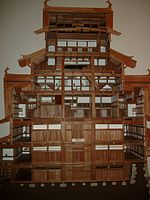Sandō
Appearance

A sandō (参道, visiting road) in Japanese architecture is the road approaching either a Shinto shrine or a Buddhist temple.[1] Its point of origin is usually straddled in the first case by a Shinto torii, in the second by a Buddhist sanmon, gates which mark the beginning of the shrine's or temple territory. There can also be stone lanterns and other decorations at any point along its course.
A sandō can be called an omote-sandō (表参道, front sandō), if it is the main entrance, or an ura-sandō (裏参道, rear sandō) if it is a secondary point of entrance. The famous Omotesandō district in Tokyo, for example, takes its name from the nearby main access path to Meiji Shrine.[2] An ura-sandō also used to exist.
Gallery
-
A Buddhist sandō
-
A sandō in Osaka
-
A sandō with stairs
See also
- Shendao, a decorated road to a grave of an emperor or another dignitary in China
References
- ^ Iwanami Kōjien (広辞苑) Japanese dictionary, 6th Edition (2008), DVD version.
- ^ "Omotesandō ga aru nara, Urasandō mo aru no de wa" (in Japanese). Ameba News. Retrieved 4 December 2009. [dead link]





